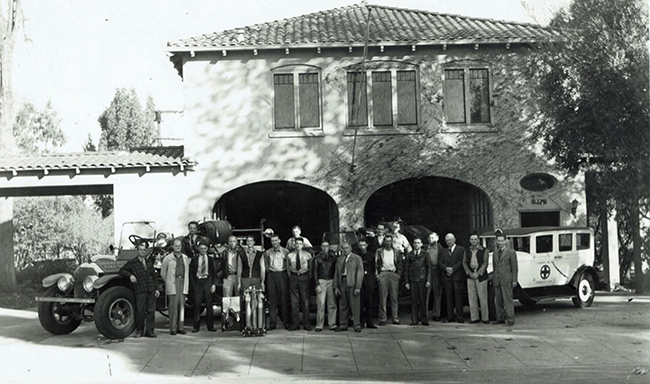Council elects to gradually cut size of police commission
by Steven Felschundneff | steven@claremont-courier.com
The Claremont City Council struck a balance Tuesday night between the wishes of advocates of justice reform, who asked that the police commission remain at its current size of nine members, and ongoing city precedence, which establishes commissions as seven-member panels.
By a unanimous vote, the council decided to take advantage of an upcoming vacancy on the police commission and temporarily reduce the size of the panel by one member beginning in August. It would then revert to its original seven-member size through attrition over the coming year.
Following the murder of George Floyd in May 2020, residents of Claremont called for a review of police policy and tactics that included a two-year expansion of the police commission. At the time, activists pointed to a lack of diversity on the all-male panel, including three with law enforcement backgrounds.
The two new members added in August 2020 were Rafik Mohamed, a Black university professor with a Ph.D. in criminology, law and society, and Becky Margiotta, a longtime Claremont resident who works as an executive in the nonprofit sector and is a member of the LGBTQ community.
Those two commission seats were scheduled to be eliminated next month, which spurred the call to keep the commission from reverting to its less diverse composition.
The original administrative item called for the council to decide on a panel of either seven or nine members. However, Councilmember Corey Calaycay recommended the eight-person compromise because police commission member Jon Strash will reach his eight-year term limit in August.
Chair Frank Bedoya’s four-year term also ends in August, so the council could have elected to go back to seven members and let an ad hoc committee, comprised of Mayor Jed Leano and Mayor Pro Tem Ed Reece, make the difficult decision on which sitting member would not continue. Calaycay cited a longstanding precedent of not removing commissioners in good standing as a chief reason for the eight-person compromise.
Tuesday’s council action only establishes the number of commission seats. It will be up to the ad hoc committee to decide how to fill the two seats.
Since commissioners volunteer their time, one might wonder why it matters how many are seated. The answer came from City Manager Adam Pirrie who, responding to a question from the council, confirmed that the commissions generate a fair amount of work for his staff, and an expanded police commission had not been accounted for in the budget. Calaycay expressed concern that other commissions might ask to expand their numbers, further taxing city employees.
The anticipated date when the panel reverts to seven members will be August 2023, when commissioners Caleb Mason and John Perez reach their term limits.
Leano and Stark to write cannabis tax statement
Also during Tuesday’s meeting, the council heard a second reading of an ordinance to put the proposed retail and commercial cannabis tax on the November midterm election ballot.
Although the council passed the ordinance during its last meeting, it is required to have a second reading before being placed before the voters. This also presented the council with the option of writing a statement, either in favor of or against the ballot measure, which will appear in the official voter’s guide.
Following a fair amount of debate over the intricate mechanics of the official statement, Leano and Councilmember Jennifer Stark were selected to compose a statement in favor of passing the tax.
The proposed retail tax would apply to both storefronts and delivery services, with a range of 4% to 7%. Voters will be asked to approve the range rather than a fixed rate in order to give the council flexibility in tailoring the final rate to match market conditions.
For non-retail cannabis businesses, the tax would be based on either gross receipts, or for cultivation, the square footage of the grow area.
Per city ordinance, there are currently no cannabis businesses in Claremont, thus the tax would only go into effect if that policy changes at some point.
During its June 28 meeting, the council passed the proposed ordinance 4-1, with Reece voting no because he wanted to give voters a wider percentage range in the tax.
“The proposed ordinance would not allow such businesses; rather, it would merely establish tax rates if such businesses were allowed in the future through the adoption of cannabis-related business and land-use regulations,” according to a staff report from the June 28 meeting.
Claremont comes up big in first month of water conservation
During her report about councilmembers’ outside appointments, Stark, who is the vice chair of the San Gabriel Valley Council of Governments’ Water Policy Committee, delivered the news that Claremont residents used 45% less water last month compared to a year ago. In June 2022, city ratepayers used 300 acre feet of water, compared with 525 acre feet in June of 2021.
“I commend the community for that tremendous effort,” Stark said. “I know it was not voluntary.”
In May, the city’s provider, Golden State Water, announced that due to the ongoing drought, outside watering would be reduced to once per week and all residents would be asked to cut back overall usage by 20% over the previous year’s consumption.
Driving around Claremont it’s clear the restrictions are having a tremendous impact, with many lawns and yards looking very dry.
Claremont receives 45% of its water from the State Water Project, and The Metropolitan Water District indicated it will reevaluate the city’s conservation efforts in September and determine whether further cutbacks are needed.










0 Comments